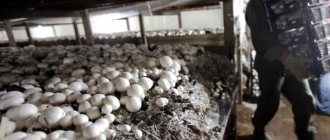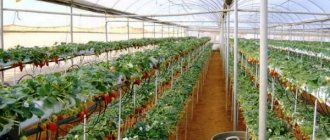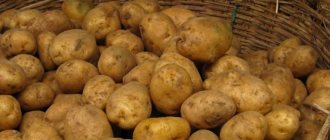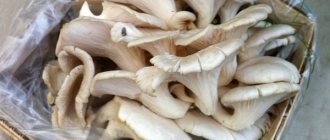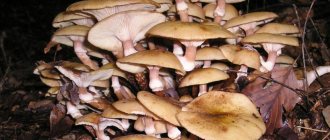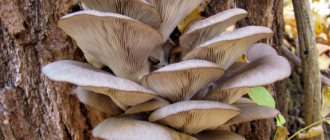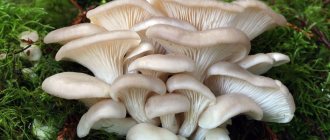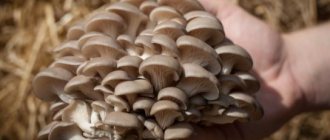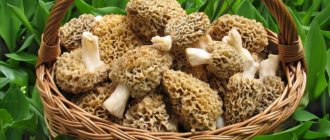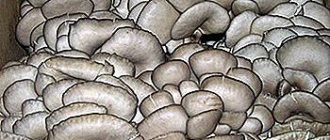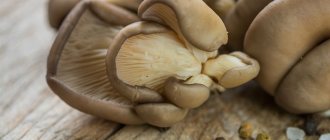Mushrooms
0
1340
Article rating
Kira Stoletova
Unpretentious oyster mushrooms do not require careful care and do not require large financial expenditures, which is why even inexperienced summer residents use the cultivation of oyster mushrooms in the country.
Growing oyster mushrooms in the country
Oyster mushroom growth conditions
Growing oyster mushrooms does not require complex substrate preparation technology. This crop has a number of varieties that vary in shape, color, texture and aroma. Oyster mushrooms can be grown both indoors (greenhouse) and outdoors, throughout the year in various agroclimatic conditions. Since these mushrooms have a fast growth rate (60 days), 5 to 6 harvests can be harvested per year.
Oyster mushroom can grow at temperatures from +8°C to +20°C (depending on the strain) and humidity 55–70% for 6–8 months a year. During the summer months, additional humidity may need to be provided.
Oyster mushroom can be grown on large amounts of agro-waste containing cellulose and lignin. These include:
- rice, wheat straw;
- stalks and leaves of corn, millet;
- sawdust;
- peeled corn cobs;
- dry herbs;
- sunflower stems;
- discarded waste paper;
- synthetic compost.
The room must have sufficient ventilation to ensure good fruiting.
Mycelium selection
It is important to choose the right strain before growing oyster mushrooms. To grow mushrooms on substrate blocks, they use mycelium that was produced in special laboratories. Of course, mushroom mycelium must be purchased from trusted suppliers, since it must be sterile, and this can only be achieved using special production technologies.
Indicators of quality mycelium:
- Sterility. Keep it in a sealed bag with biofilters.
- Number of reseedings , i.e. the use of seed from other manufacturers. This will negatively affect the yield and its quality.
- Strain (variety). Before purchasing, you need to make sure that this strain has good characteristics and is widely used in mushroom production, i.e., it is not outdated.
Reliable dealers supply high-quality products that are free of various microorganisms (bacteria, lower fungi, mold).
There are winter and summer varieties of oyster mushroom mycelium. They are divided into:
- single-wave - giving a large harvest in the first stage of fruiting;
- two-wave - giving an even harvest between two stages of fruiting.
Strains may have differences: in terms of requirements for growing conditions, external characteristics (color, size), productivity, resistance to various diseases. When purchasing mycelium, you need to check the sowing date (shelf life). The packaging must not be damaged. The material must be free from bloom and mold and have a mushroom aroma.
Preparing the growing site
You need to carefully consider the choice of place to grow oyster mushrooms: it can be either a summer cottage or a garden plot. Mushrooms can grow in substrate in a greenhouse, on wood in a garden, and even in a vegetable garden.
Also find out whether oyster mushrooms need to be cleaned and how to process them.
On wood in the garden
It is preferable to plant oyster mushrooms on freshly cut wood, although mushrooms will grow just as well on older logs. Mushroom material grows in partial shade, but can withstand direct sun. The ideal place to grow it is in a perennial garden.
In the fall, 2-3 round timber of deciduous trees are selected (aspen, birch, poplar or willow are suitable). Their length can be from 50 cm to 1 m. Diameter is from 17 to 27 cm.
To prevent the wood from drying out, it must be placed in a shaded place on a hill. Make transverse cuts 7–10 cm deep on the side and end (can be in a circle). The distance between the perforations along the length and along the radius should be about 10 cm.
In a substrate in a greenhouse
Oyster mushrooms are very convenient to grow in a greenhouse, especially at a time when it is free from other plants. It is worth noting that the humus remaining after growing mushrooms can later be used as fertilizer. Growing oyster mushrooms in a greenhouse opens up great opportunities:
- Growing for commercial purposes.
- Easy to care for.
- Obtaining an environmentally friendly product.
- Convenient way to grow.
- High yield.
- Short performance period.
- Possibility to grow both in winter and year-round.
To grow mushrooms, you need to choose a method that is convenient for you.
There are two such ways. The first includes cultivation on charcoal, the second - agroponics in bags. An important condition for growing mushrooms in winter is the need for heating and minimal lighting. To prevent sunlight from penetrating, use darkening film or agrofibre. Glassed or covered with transparent film greenhouses are not suitable for growing oyster mushrooms.
Did you know? Oyster mushroom mycelium kills and eats nematodes (small roundworms) and bacteria, making them one of the few carnivorous fungi.
The humidity level in the greenhouse should be quite high.
To achieve high humidity, you should place containers of water around the entire perimeter, the distance between them should be about one and a half meters. Also, the substrate and walls of the greenhouse must be sprayed regularly (daily) with water.
Video: Growing oyster mushrooms in a greenhouse
Using oyster mushrooms
Oyster mushroom has excellent taste and nutritional properties. You can prepare many delicious dishes from oyster mushrooms. It should be noted that oyster mushrooms do not need long soaking, you just need to rinse thoroughly.
Oyster mushrooms are often frozen, dried, pickled, salted, and, of course, used fresh.
From August to September you can pamper yourself and your family with fried oyster mushrooms or delicious soups. If you combine mushrooms with vegetables, you can get great stews, pies, pancakes and many other excellent dishes. Caviar made from oyster mushrooms, carrots and onions is especially popular. You can delight your guests in two ways by preparing several oyster mushroom dishes at once.
These mushrooms are rich in vitamins and elements necessary for the normal functioning of the human body. In addition, they will delight women watching their weight with their low calorie content.
Landing
By strictly following the recommendations when planting oyster mushrooms, you will be able to get a good harvest of mushrooms.
Algorithm for planting oyster mushrooms on wood in a greenhouse:
- Prepare wood blocks from 50 cm to 1 m long.
- Make perforations (cuts) 7–10 cm deep. The distance between cuts should be about 10 cm.
- Place the mycelium in the holes and seal them with sawdust or moss. Moisturize.
- Cover the floor of the greenhouse with plastic film.
- Prepare a mixture of 1 part sand, 1 part soil, 2 parts sawdust. Cover the film with three quarters of this soil mixture.
- Place round timber on the floor at a distance of 30–40 cm from each other. Sprinkle the rest of the soil mixture on top and sprinkle some manure on top.
- Cover everything with agrofibre.
Algorithm for planting oyster mushrooms in bags in a greenhouse:
- Straw needs to be stuffed into plastic bags.
- Place bags of straw in hydrothermal containers.
- Press on top with a wire rack.
- After a while, pull out the heavy bags using a hoist (suspended load-lifting device, hoist).
- Crush the grain mycelium well with your hands.
- After the straw has cooled, stuff it into mushroom blocks with small holes or air filters for air exchange, compacting well and laying the layers of straw with mycelium.
- Pack the blocks with tape.
- Place the bags in the germination room for 15–20 days, it should be warm (up to +20...+24°C) and dark. These are the necessary conditions for incubation and the beginning of the first growth phase.
- After the specified time has passed, transfer the blocks to another workshop, where it is cooler +12...+17°C. Now the mushrooms need higher humidity of 80–90% and ventilation of the room for 1 hour a day.
- For good mushroom growth, you should use an automatic watering system. If there is no such system, then the bags can be sprayed with water. You cannot overdo it with spraying, otherwise the straw may rot.
1 - moistening and mixing the substrate;
2 - mixing the pasteurized substrate with mycelium; 3 - making cuts on a bag filled with seeded substrate; 4 - placement of blocks for growing mushrooms on racks with vertical hanging. Mushrooms can be harvested 7 days after the start of growing from the bag, for 3 times until the mycelium is depleted. In this case, a new crop of mushrooms will appear every 7-14 days during this time. In other words, it takes about 5-8 weeks to grow 3 crops of oyster mushrooms and can be done with minimal equipment and experience. More than 500 kg of fresh mushrooms per 1 ton of dry straw can be obtained in 45–50 days.
Important! When harvesting oyster mushrooms grown in bags, they cannot be cut off, as the mushroom roots may deteriorate, which will lead to rotting of the entire block. It is better to do this by grabbing the entire fruiting body and twisting it.
Algorithm for planting oyster mushrooms on wood in the garden:
- Before laying the mycelium, you need to knead it with your hands.
- Pour the mycelium into the holes in the wood and tamp lightly. So fill each hole.
- Pack the mycelium with fresh, damp sawdust from deciduous trees and forest moss on top. This is done to prevent the mycelium from drying out.
- In a shady place in the garden, dig a hole 10 cm deep. Pour sawdust into the bottom and pour water over it to keep it moist.
- Add a handful of fresh mycelium on top of the sawdust.
- Place the wood with the butt part down in the hole, sprinkle earth around it, and tamp it down.
Tree posts do not need to be covered for the winter. If the oyster mushroom growing region is hot and dry, you will need to keep the logs moist and cool. To create a greenhouse effect, it is better to cover the wood with film; it is preferable that it be defective. This is necessary in order to create a greenhouse effect. The film should remain on the wood for about 2-3 weeks. In spring you can expect the first mushrooms to appear.
Such wood will bear fruit 2 times a year, in spring and autumn. Important! If you mix up and place the wood with the wrong side down, then you won’t have to wait for mushrooms, because moisture will not rise up the fibers and will not be able to nourish the oyster mushrooms.
How to grow oyster mushrooms at the dacha in a greenhouse
Many novice mushroom growers are interested in how to grow mushrooms at home year-round. A heated greenhouse is best suited for this purpose, in which it is easy to create conditions suitable for the growth of mushrooms (Figure 6).
For cultivation to be successful, the greenhouse must be equipped with heating devices, powerful fans installed, and the walls and roof covered with insulation (for example, polystyrene foam). This will create a stable indoor microclimate.
Figure 6. Features of growing in a greenhouse
Since oyster mushrooms do not require bright lighting, it is better to shade the greenhouse with camouflage netting. If you have a glass structure, the walls must be painted with white paint.
Note: Even the greenhouse in which vegetables are grown in normal times is suitable for growing. But, if you want to combine the cultivation of different crops, you can only grow oyster mushrooms together with cucumbers, since they have approximately the same requirements for temperature and humidity conditions.
You can grow mushrooms in a greenhouse in any convenient way. The easiest way is to bury wooden logs infected with mycelium inside. But you can use another method: hang boxes with substrate and mycelium from the ceiling or place boxes with substrate and mycelium on shelves, or hang blocks in plastic bags.
Care during growth
Oyster mushrooms do not require special care. The key to successful cultivation is maintaining the correct air humidity and temperature, keeping the room clean, controlling watering and ventilation. The mushroom farm must be protected from flies and other insects from the street.
Oyster mushrooms are susceptible to diseases such as yellow spot, brown spot (bacteriosis) and bacterial rot.
Necessary disease control measures include:
- proper management of temperature and humidity during the growing season;
- the use of water containing 20 mg/l of chlorine and the Biospot preparation, which has proven itself to solve problems with fungal bacteriosis, for spraying affected mushrooms;
- use of oxytetracycline and streptocycline.
Did you know? Cooks of Ancient Rome highly valued edible mushrooms. The so-called Caesar or royal mushroom got its name precisely because it was considered a delicacy worthy of an emperor.
How to properly care for oyster mushrooms
Despite the fact that oyster mushrooms are considered unpretentious mushrooms, they need proper care for a bountiful harvest. It consists of maintaining optimal temperature, humidity and high-quality ventilation.
For example, at the initial stage, when the mycelium is just beginning to sprout, the light in the room is not turned on, while ensuring good ventilation to prevent overheating of the mushroom blocks.
After the first fruiting bodies appear, artificial lighting is turned on. Its duration is no more than 10 hours a day. The temperature is reduced, ensuring a fairly high level of humidity (about 90%).
Climatic conditions, incubation period
Oyster mushrooms grown at home on sawdust or other breathable substrate ripen quite quickly. No more than three weeks pass from the moment the mushroom blocks are moved until the harvest.
Each growing period is characterized by its own temperature and humidity conditions. At the initial stage, when the mycelium is just beginning to germinate, the humidity in the room should be no more than 70% at a temperature of +18+22 degrees. The light is not turned on, as it slows down the germination of the mycelium.
Harvesting
Fruiting bodies should be collected before releasing spores by twisting, so that no stumps remain on the beds (straw). It is advisable to collect all the mushrooms from the block at once, then the next stream will appear at the same time.
Fresh mushrooms should be packaged in perforated plastic bags. Freshly picked oyster mushrooms can be stored at low temperatures (+5...+10°C) for 1-2 weeks. without loss of quality. After harvesting, the room must be disinfected - first with water and then with a sulfur bomb.
Pay attention to the information about freezing oyster mushrooms.
Not many people practice mushroom cultivation, mainly due to fears of an unusual activity. Often the difficulties seem too great and the wait too long. However, when an ordinary log or bag turns into a treasure trove of delicious delicacies, all doubts immediately dissipate.
Fruiting and care
During the fruiting period, you will need eight hours of lighting with artificial lamps, a high percentage of humidity, frequent ventilation and a temperature not higher than 15 degrees.
To create high humidity, you can spray the walls and flooring with water, but the water should in no way get on the substrate.
If all standards are met, mushrooms will appear within two weeks from these slits. To prevent the remains of the fruiting mushroom bodies from rotting inside, it is better to twist the mushrooms rather than cut them.
The substrate can be used for growing oyster mushrooms for no more than four mushroom harvests. You can use a loggia, basement, attics, etc. as a place for growing. Oyster mushrooms do not like direct sunlight, so it is better to use dark places. Maintaining a normal microclimate will yield a harvest of 25 to 40% of the weight of the entire substrate.
Harvesting:
- It is better to harvest 5-6 days after the mushrooms form.
- Optimally, the cap should have a diameter of 40-100 mm, the stem 10-40 mm.
- The cap of the fungus at the very beginning of its development is dark in color, later it becomes ash-gray, and only at the end it sharply discolors.
- If the mushroom is overripe, the cap begins to break and the stem hardens.
- The marketable appearance deteriorates, and along with it all the taste and nutritional properties decrease.
- Fresh mushrooms should be stored at 0-5 degrees above zero for a week, and for about 6 hours at a temperature of about 20 degrees above zero.
- Selectively cutting off mushrooms is not recommended! In general, cutting the crop should be careful and leisurely so as not to damage the mycelium.
- When cold weather sets in, you need to cover the mushroom beds with straw if they are grown outdoors.
Some of the summer residents have been successfully building a business growing oyster mushrooms for quite a long time. High demand and minimal cultivation costs bring significant profits.
Types of oyster mushrooms for home cultivation
At home, you can grow almost any type of oyster mushroom, but the following varieties are considered the most popular (Figure 12):
- Oyster - characterized by low maintenance, resistance to low temperatures, high yield and valuable taste.
- Pink and lemon differ not only in their good taste, but also in the unusual color of their fruiting bodies. In addition, they are found only in the Far East, but are quite successfully cultivated under artificial conditions.
- Steppe is considered the most delicious variety. In addition, it is quite large, so it is grown in large barrels or cans.
Figure 12. Types of oyster mushrooms for home cultivation: 1 - oyster, 2 - pink, 3 - lemon, 4 - steppe. It is
also customary to grow common and Florida oyster mushrooms at home. These are unpretentious varieties that are characterized by a fairly large size of fruiting bodies and high yield.
Growing champignons in the garden
Growing champignons in an open area begins with creating trenches 1 m long and 1 m wide, and 30 cm deep, into which tops, rotted mullein, liquid manure and turf sprinkled on top are placed in the fall. In the spring, a substrate is prepared from rotted manure and straw; in addition, you can add bird droppings (5–6 kg) and ammonium nitrate (2–3 handfuls) per 20 liters of manure. The resulting mixture is placed on top of the trenches and kept for a week. The plantation is protected from northern winds and sun using glass and film. Additionally, strips 5–6 cm wide are laid on the film with an interval of 2–3 cm so that no more than 30–40% of sunlight penetrates.
The mycelium is broken and stuck into the already scattered substrate, maintaining a gap of 30–40 cm. The holes are sprinkled with slightly moistened compost. After the mycelium germinates (after 2 weeks), the soil surface is slightly loosened to improve aeration and light watering is carried out periodically.
